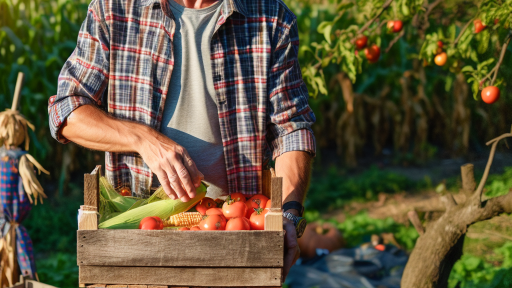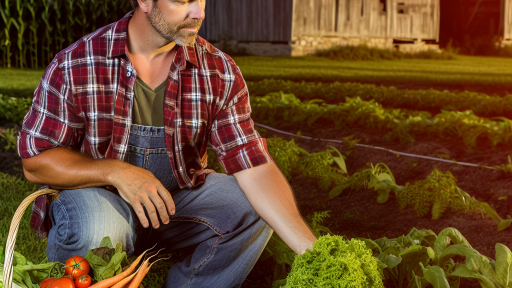Introduction
Strengthening farm-to-table strategy emphasizes direct connections between farmers and consumers.
It focuses on sourcing food locally, minimizing transport, and improving freshness.
This approach fosters transparency in food production.
Consumers gain insight into where their food comes from.
The concept champions seasonal and sustainable eating practices.
It promotes the use of local ingredients, enhancing flavor and nutrient quality.
Importance of local sales for farmers and local economies
Local sales directly benefit farmers by providing a reliable income source.
They enable farmers to maintain a sustainable livelihood and invest in their communities.
Strengthening local economies leads to better job opportunities.
Increased local purchasing power stimulates economic growth and resilience.
Farmers can also reduce transportation costs, maximizing their profits.
Additional sales in local markets reduce food waste by matching supply with immediate demand.
Overview of how strengthening farm-to-table strategies can enhance sales
Enhancing farm-to-table strategies increases consumer awareness and loyalty.
Farmers can leverage social media to promote their products.
Engaging storytelling about farming practices attracts more customers.
Partnerships with local restaurants boost visibility and attract new buyers.
Offering farm tours creates authentic experiences, strengthening community ties.
Participation in local events showcases products directly to consumers.
By ensuring quality and freshness, farmers build a loyal customer base.
Clear branding and marketing highlight the unique value of local products.
Educational initiatives help consumers understand the benefits of buying local.
These strategies not only attract new customers but also encourage repeat business.
Ultimately, a well-executed farm-to-table strategy generates enthusiasm for local sourcing.
Understanding the Farm-to-Table Movement
Definition and History of the Farm-to-Table Movement
The farm-to-table movement emphasizes direct connections between consumers and local food producers.
It seeks to provide fresh, seasonal produce directly from farms.
This approach fosters sustainable practices while reducing food miles.
The movement gained traction in the late 20th century, during an increasing awareness of food quality.
Consumers started questioning food sources, seeking transparency in their diets.
Early advocates of this movement focused on organic farming and sustainability.
They emphasized the nutritional benefits of eating local foods.
One can trace the origins of farm-to-table to the 1970s, when culinary figures championed local ingredients.
Chefs began to cultivate strong relationships with local farmers in order to guarantee quality.
This partnership showcased seasonal ingredients in innovative dishes.
As sustainability emerged as a critical issue, farm-to-table restaurants gained popularity.
They became symbols of conscious consumerism.
Over decades, the movement expanded beyond restaurants to farmers’ markets and grocery stores.
Now communities nationwide embrace the farm-to-table philosophy.
Today’s consumers want to know where their food comes from and how it’s produced.
Benefits of Local Sourcing for Consumers
Local sourcing brings numerous benefits for consumers.
These advantages directly impact health, environment, and community.
Here are some key benefits:
- Freshness: Locally-sourced produce offers superior freshness.
It travels shorter distances, reaching consumers quickly. - Nutritional Value: Fresh foods retain more nutrients.
They are often harvested at peak ripeness, enhancing taste and benefits. - Seasonal Variety: Eating locally encourages consumers to try new flavors.
Seasonal eating fosters a diverse diet based on current produce. - Reduced Environmental Impact: Shorter supply chains lower carbon footprints.
Less transportation also means fewer emissions and energy consumption. - Support for Local Economies: Purchasing local goods supports nearby farmers.
This strengthens local economies and enhances community development. - Community Connection: Building relationships with local producers fosters community ties.
People feel a sense of belonging within their local food systems. - Transparency: Local sourcing often means more information about food origins.
Consumers can make informed choices about their meals. - Flavor: Local foods often taste better due to freshness and quality.
The connection to regional soil and climate enhances flavor complexity.
The Growing Consumer Demand for Fresh, Local Produce
Consumer demand for fresh, local produce continues to rise as more people prioritize health and sustainability in their food choices.
This growing interest in farm-to-table practices especially resonates with younger generations seeking authentic, value-driven food experiences.
Survey data shows significant shifts in behavior:
- 60% of consumers prioritize local sourcing in their purchases.
- Over half believe local food is healthier than non-local options.
Digital platforms have accelerated this trend.
Social media promotes local farms and producers, with consumers sharing favorite local businesses and eateries online.
This creates strong community support for local sourcing.
Apps and websites also make it easier to locate nearby farms, markets, and restaurants.
Producers benefit greatly:
- Farmers’ markets experience increased traffic.
- Seasonal events featuring local produce attract enthusiastic crowds.
- Restaurants serving local dishes build loyal customer bases, driven by consumers’ trust in fresh ingredients.
Retailers and restaurants adapt by partnering with local farms to meet demand.
They highlight locally sourced goods to enhance brand appeal and community standing.
Local sourcing aligns with consumer expectations and boosts profitability.
The farm-to-table movement presents a win-win:
- Consumers enjoy fresh, nutritious food.
- Producers expand operations to meet growing demand.
- Local economies and sustainability efforts thrive.
As the movement grows, it stimulates further interest in environmental responsibility, strengthening local agricultural systems and fostering vibrant food cultures.
Transform Your Agribusiness
Unlock your farm's potential with expert advice tailored to your needs. Get actionable steps that drive real results.
Get StartedIn fact, farm-to-table practices benefit consumers, farmers, and communities.
By supporting local sourcing, the movement enhances health, promotes environmental stewardship, and fuels economic growth.
Cultivating strong ties between farmers and consumers remains vital for the future of sustainable food systems.
Assessing Your Current Farm-to-Table Strategy
To strengthen your farm-to-table strategy, you must first assess your current operations.
This evaluation will help you identify strengths, weaknesses, and areas requiring improvement.
A well-rounded assessment involves three crucial components: evaluating existing supply chains, identifying key stakeholders, and recognizing gaps and opportunities.
Evaluating Existing Supply Chains
Understanding your existing supply chain is vital.
This insight will help you determine how effectively you deliver products from farm to table.
Here are several factors to consider when evaluating your supply chains:
- Source of Ingredients: Where do you obtain your ingredients?
Assess the reliability and quality of these sources. - Transportation Methods: Examine the vehicles and mediums used to deliver products.
Are they efficient? - Storage Practices: Review how you store products before delivery.
Is the storage climate-controlled?
Are products kept fresh? - Timing of Deliveries: Analyze your delivery schedules.
Are they meeting customer demands? - Cost Efficiency: Calculate the costs associated with each stage of the supply chain.
Identify potential areas where expenses could be reduced.
Gather feedback from your partners within the supply chain.
Their insights will provide a broader view of the existing processes.
Utilize surveys or interviews to collect this information.
This feedback can reveal hidden challenges and opportunities.
Identifying Key Stakeholders Involved in Your Current System
Your farm-to-table strategy involves multiple stakeholders.
Identifying these key players helps you align your goals effectively.
Consider the following stakeholders:
- Farmers: Evaluate your relationships with local farmers.
Are they reliable partners for quality produce? - Distributors: Identify the distributors you work with.
Do they maintain high delivery standards? - Restaurants: Consider the local restaurants you partner with.
Are they promoting your products in their menus? - Consumers: Understand your target consumers.
What are their preferences and expectations regarding local produce? - Community Organizations: Engage with local organizations focused on promoting local agriculture.
They can assist in connecting you with potential customers.
Facilitating open communication among these stakeholders strengthens relationships.
Regularly discuss feedback, trends, and shifts in consumer behavior.
This collaboration promotes transparency and fosters a tight-knit community.
Recognizing Gaps and Opportunities for Improvement
After evaluating supply chains and stakeholder alignment, identify gaps that present opportunities for improving your strategy.
Focus on the following areas:
- Product Quality: Identify inconsistencies and determine where improvements can be made.
- Market Reach: Are you reaching your potential customer base?
Explore new marketing channels. - Brand Awareness: Is your brand visible in the local community?
Invest in marketing to enhance visibility. - Customer Feedback: Are you actively seeking consumer feedback?
Use surveys or focus groups to gauge satisfaction. - Educational Opportunities: Do consumers understand farm-to-table benefits?
Host workshops or informational sessions.
After identifying gaps, brainstorm potential solutions.
Implement quality control measures to ensure product consistency.
Enhance your marketing by promoting your unique selling points.
Leverage social media for broader outreach.
Use technology to streamline processes.
Inventory management software helps track supplies, preventing waste and improving delivery efficiency.
Adapt to changes in consumer preferences and market trends.
Highlight local sourcing by sharing farmers’ stories.
Creating a personal connection fosters customer loyalty and repeat business.
Regularly assess your farm-to-table strategy to keep operations aligned with market demands.
Reassess methods to optimize for efficiency and effectiveness.
Incorporating these evaluations into your business model ensures success.
Engage all stakeholders in the changes you intend to implement.
Their support is essential for the strategy’s growth.
In short, assess your farm-to-table strategy by examining supply chains, stakeholders, and areas for improvement.
This process requires active engagement and honest evaluation.
As you strengthen your strategy, expect increased local sales and stronger community support.
Read: How Farm-to-Table Is Changing Dining Forever
Building Strong Relationships with Local Producers
Importance of Collaboration Between Farmers and Local Businesses
Collaboration between farmers and local businesses enhances the farm-to-table movement.
It plays a critical role in ensuring freshness, quality, and consistency.
Strong relationships foster a sense of community and shared purpose.
Here are several benefits of collaboration:
- Access to Fresh Ingredients: Local businesses enjoy fresh produce that boosts their menu offerings.
- Increased Customer Loyalty: Consumers prefer knowing where their food comes from, gaining trust in local brands.
- Economic Support: Local partnerships help support local economies, retaining more money within the community.
- Shared Marketing Efforts: Both farmers and local businesses can combine marketing efforts to reach wider audiences.
- Innovation in Offerings: Collaboration allows for menu innovation using seasonal ingredients inspired by local harvests.
By building strong partnerships, local producers create a network that enhances the sustainability of both farmers and businesses.
Strategies for Fostering Partnerships with Restaurants and Markets
Developing effective strategies is essential for creating lasting partnerships with local producers.
Here are some approaches to consider:
- Networking Events: Host networking events that facilitate interaction between local farmers and business owners.
- Farm Tours: Organize farm tours for restaurant owners, providing them with firsthand experiences of local farms.
- Collaborative Promotions: Launch joint promotions that highlight local ingredients used in restaurant dishes.
- Community Supported Agriculture (CSA): Encourage restaurants to join CSAs, enhancing their access to local produce.
- Cooking Demonstrations: Arrange cooking demonstrations featuring local ingredients to showcase their versatility.
- Seasonal Menus: Encourage restaurants to create seasonal menus that reflect what’s available locally.
Implementing these strategies strengthens relationships and creates a supportive farm-to-table ecosystem.
Case Studies of Successful Local Producer Partnerships
Examining successful partnerships can provide insights and inspiration.
Here are some case studies that exemplify effective collaborations:
The Grain and Vegetable Co-op
This co-op engaged local restaurants to create a shared sourcing platform.
The initiative allowed restaurants to order bulk grains and vegetables from local farmers.
As a result:
- Reduced Costs: Restaurants saved on delivery fees and improved profit margins.
- Quality Control: Chefs gained direct access to quality ingredients, improving menu options.
- Customer Engagement: The co-op held events showcasing local farms, enhancing community ties.
The Farmers’ Market Partnership
A group of farmers collaborated with a local market to create a farm-to-table initiative.
This partnership allowed:
- Weekly Promotions: The market featured weekly promotions highlighting different farmers and their products.
- Educational Workshops: Workshops taught consumers about the benefits of eating locally.
- Local Recipe Cards: Restaurants contributed recipes using market ingredients, promoting cross-marketing.
Chefs for Futures
Chefs for Futures connected local chefs with farmers for a unique program.
This program integrated local producers into restaurant operations, leading to:
- Seasonal Partnerships: Chefs receive updates about seasonal availability from local farms.
- Special Events: Restaurants host special events to celebrate the harvest, attracting new customers.
- Greater Transparency: Customers learned about local sourcing and participated in farm visits.
These case studies demonstrate the power of collaboration in the farm-to-table movement.
By fostering strong partnerships, local businesses can enhance their offerings while supporting local agriculture.
Strengthening relationships between local farmers and businesses represents a win-win for everyone involved.
By emphasizing collaboration, these partnerships sustain local economies while providing fresh, high-quality ingredients to customers.
With effective strategies in place, local producers can build stronger ties to the community.
The stories of successful collaborations serve as inspiration for new initiatives, enhancing the farm-to-table movement’s vitality.
Together, local farmers and businesses can create a more vibrant and sustainable food system.
Read: Organic Hero: Sarah’s Farm-to-Table Dream
Showcase Your Farming Business
Publish your professional farming services profile on our blog for a one-time fee of $200 and reach a dedicated audience of farmers and agribusiness owners.
Publish Your ProfileEnhancing Marketing Efforts
Improving your marketing strategies is essential for promoting your farm-to-table initiative effectively.
By adopting innovative approaches, you can reach a wider audience and increase local sales.
Here are some strategies to enhance your marketing efforts.
Crafting a Compelling Narrative Around Your Farm-to-Table Offerings
Storytelling plays a significant role in attracting customers.
A strong narrative can resonate deeply with your audience.
Here are some key components to include in your narrative:
- Your Farm’s History: Share the story of how your farm began.
Highlight your mission and values. - Local Ingredients: Explain the sourcing of your ingredients.
Emphasize any organic or sustainable practices you use. - Community Impact: Discuss how your farm supports local economies.
Talk about jobs created and partnerships formed. - Unique Products: Showcase any unique products you offer.
This can include heirloom vegetables or rare breeds of livestock. - Customer Testimonials: Incorporate stories or feedback from satisfied customers.
This can help build trust and credibility.
Once you have crafted your narrative, incorporate it into all your marketing materials.
Use your story to create emotional connections with potential customers.
Utilizing Social Media and Online Platforms for Outreach
In today’s digital age, social media is a powerful marketing tool.
It allows you to engage with your audience directly and showcase your farm’s offerings.
Consider the following platforms and strategies:
- Instagram: Post high-quality photos of your food, farm activities, and community events.
Use relevant hashtags to expand your reach. - Facebook: Share updates, promotions, and news about your farm.
Create event pages for special events or farmers’ markets. - Twitter: Tweet about daily happenings on your farm.
Share quick tips for cooking with fresh ingredients. - Blogging: Start a blog on your website to share recipes, farming tips, or stories about your farm.
This can help improve SEO. - Email Marketing: Build a mailing list to keep customers informed about new offerings, events, or promotions.
Send regular newsletters to keep your audience engaged.
Be consistent with your online presence.
Respond to comments and messages promptly.
This engagement demonstrates your commitment to customer satisfaction.
Developing Local Branding and Community Engagement Initiatives
A strong local brand can significantly impact your farm-to-table strategy.
When customers feel a connection to your brand, they are more likely to support your business.
Here are some ways to strengthen your local branding:
- Create a Memorable Logo: Invest in a professional logo that represents your farm’s values and mission.
Make it recognizable across all platforms. - Participate in Local Events: Engage in farmers’ markets and community festivals.
Offer samples and interact with customers to raise awareness. - Collaborate with Local Chefs: Partner with local restaurants to feature your products in their menus.
This can highlight your offerings and drive customers to your farm. - Host Farm Tours: Organize tours for your community.
Show visitors around your farm, explaining your practices and producing fresh food. - Community Workshops: Hold workshops focusing on cooking with fresh ingredients.
This can foster deeper relationships with local consumers.
Brand loyalty can increase when you actively engage with your community.
Support local initiatives that align with your values.
This demonstrates your commitment to the local area and can enhance your reputation.
Don’t forget to measure the effectiveness of your marketing efforts.
Utilize tools like Google Analytics to track online engagement.
Survey customers to gauge their perceptions of your brand and initiatives.
Adjust your strategies based on the collected feedback.
By enhancing your marketing efforts through storytelling, social media outreach, and community engagement, you can strengthen your farm-to-table strategy.
These initiatives will help build recognition, foster customer loyalty, and ultimately boost local sales.
Read: Sustainable Farms: Talking with Farmer Lee

Educating Consumers on the Benefits of Local Produce
Educating consumers about the advantages of local produce can greatly enhance your farm-to-table strategy.
Awareness leads to a stronger commitment to buy local.
This commitment can directly affect your sales and the local economy.
Workshops, Farm Tours, and Community Events
Hosting workshops and farm tours creates opportunities for consumers to engage with local food producers.
These events offer firsthand experiences that can inspire gratitude for local agriculture.
- Workshops: These can cover cooking techniques, preserving, and understanding seasonality.
You can also include tastings to deepen appreciation for local flavors. - Farm Tours: Bring customers directly to the source of their food.
This direct connection can build trust and loyalty.
People love to meet the farmers behind their food. - Community Events: Organize farmer’s markets and food festivals.
These events showcase seasonal produce and promote camaraderie within the community.
They can also be great marketing opportunities.
These interactive experiences turn passive consumers into informed advocates.
Engaging in such activities fosters a sense of community.
Residents are more likely to support local businesses when they understand the hard work involved in food production.
Information on the Health and Environmental Benefits of Local Eating
Consumers increasingly seek healthier food options.
Educating them on the benefits of local produce can influence their purchasing decisions.
Here are some ways to share this vital information:
- Health Benefits: Local produce often retains more nutrients.
It is usually fresher and tastier.
Emphasize that local fruits and vegetables are picked at peak ripeness. - Environmental Benefits: Buying local reduces carbon emissions.
Transporting food over long distances contributes to pollution.
Local food systems therefore promote sustainability. - Seasonality: Encourage consumers to eat with the seasons.
Seasonal eating means fresher, tastier food.
It also supports local farmers as they harvest crops at their best.
Distributing brochures or newsletters can help communicate these advantages.
Social media posts can also play a significant role in spreading this information quickly.
Educational videos can make complex topics more digestible.
Encouraging Consumer Advocacy for Local Food
Ultimately, passionate consumers become advocates for locally sourced foods.
Empowering them is essential for building a resilient local food economy.
Here are actionable strategies to encourage advocacy:
- Involve Customers: Create a “local food ambassador” program.
This program can motivate consumers to share their experiences with others.
Encourage them to post about local produce on social media. - Create Loyalty Programs: Reward repeat customers with discounts.
Create a points-based system that incentivizes local purchases.
This will increase the likelihood of continuous support. - Collaborate with Local Businesses: Partner with restaurants and cafes that support local produce.
Joint promotions can raise awareness of the benefits of eating locally. - Host Taste Tests: Offer tastings in your store or at local events.
Highlight the unique flavors of local produce.
This can spark interest and boost sales.
These actions will empower consumers with the knowledge they need.
They’ll be equipped to champion local foods because of the education you provide.
This advocacy plays a significant role in driving local sales.
To sum up, education is central to strengthening your farm-to-table strategy.
When consumers understand the benefits of buying local, they become loyal customers.
They begin to advocate for local produce, which fosters a thriving community around food.
By implementing workshops, sharing valuable information, and encouraging consumer involvement, you can create lasting connections.
These connections will not only boost your sales but also cultivate a more sustainable food culture.
Investing in consumer education is ultimately an investment in your local economy and environment.
Read: Urban Farms: A Chat with City Grower Mike
Leveraging Technology to Streamline Operations
Tools for Managing Logistics and Distribution
Effective logistics and distribution are crucial for any farm-to-table operation.
Using technology can significantly enhance these processes.
The right tools facilitate timely delivery while minimizing waste.
- Supply Chain Management Software: This software allows farmers to track their products from farm to table.
It provides visibility into inventory levels and helps coordinate orders with suppliers and retailers. - Route Optimization Tools: These tools can reduce transportation costs.
They analyze delivery routes to find the most efficient paths, resulting in shorter travel times and lower fuel expenses. - Inventory Management Systems: Proper inventory management prevents overstocking and spoilage.
These systems alert farmers and their partners when stock levels fall below a certain threshold. - Mobile Apps for Real-Time Communication: Using mobile apps connects farmers with distributors and retailers in real-time.
This instant communication helps manage orders and resolve issues quickly. - Automated Tracking Tools: Automated systems track each product’s journey.
These tools ensure transparency and accountability, which builds trust with consumers.
Implementing these logistics and distribution tools empowers farm-to-table businesses.
It enhances efficiency and improves customer satisfaction through timely deliveries.
E-Commerce Platforms for Direct-to-Consumer Sales
In today’s digital world, e-commerce platforms have become essential for farmers.
These platforms allow direct sales to consumers, eliminating middlemen.
- Online Marketplaces: Farmers can create profiles on marketplaces like Etsy or Amazon.
These platforms allow for wider visibility and increased access to potential customers. - Personalized Online Stores: Developing a personalized e-commerce site gives farmers control over their brand.
Custom websites create a unique shopping experience for customers. - Subscription Models: Implementing subscription services can ensure regular sales.
Customers receive scheduled deliveries of fresh produce, building loyalty and repeat business. - Social Media Integration: Linking e-commerce efforts with social media boosts visibility.
Platforms like Instagram and Facebook can drive traffic to online stores, attracting new customers.
E-commerce platforms provide several advantages for farm-to-table businesses.
They turn local farmers into market players, create new revenue streams, and expand their reach.
Utilizing Data Analytics for Better Market Understanding
Data analytics offer invaluable insights into consumer behavior.
By leveraging data, farmers can make informed decisions.
Understanding market trends allows them to adapt their strategies effectively.
- Consumer Preference Analysis: Analyzing customer purchases reveals preferences.
Knowing what products are in demand helps farmers adjust their offerings accordingly. - Sales Performance Tracking: Monitoring sales data over time highlights successful trends.
Recognizing which products sell best enables targeted marketing efforts. - Geographic Sales Insights: Data on sales by location reveals where demand is strongest.
Farmers can allocate resources for targeted promotions in these areas. - Seasonal Trends Analysis: Understanding how sales fluctuate with seasons helps farmers plan better.
Anticipating trends allows for strategic planting and marketing. - Customer Feedback Metrics: Gathering and analyzing customer feedback can guide improvements.
This insight aids in enhancing product quality and customer satisfaction.
Incorporating data analytics into farm-to-table strategies leads to better decision-making.
It aligns offerings with consumer needs, driving increased sales and customer loyalty.
When farmers leverage technology for operations, they build robust systems.
Each tool mentioned plays a crucial role in enhancing efficiency.
Consider integrating these technologies into everyday processes.
In a competitive market, staying ahead means embracing innovation.
Therefore, invest time and resources into these technologies today.
Adapting to technological advancements will not only increase productivity but also enhance consumer engagement.
The journey to strengthen your farm-to-table strategy is multifaceted.
By streamlining operations through technology, farmers can see significant local sales boosts.
This approach positions them favorably in an ever-evolving marketplace.
As technology continues to evolve, so should your business practices.
Regularly review and adapt your strategies to meet changing consumer demands.
Your commitment to improving operations will yield lasting benefits for your farm-to-table initiatives.
Case Studies and Success Stories
Examples of Farms That Successfully Strengthened Their Farm-to-Table Strategy
Numerous farms serve as shining examples of enhanced farm-to-table strategies.
They have implemented innovative approaches.
This has led to increased local sales. Here are a few notable cases:
- Sunny Acres Farm: This organic farm introduced a subscription service for fresh produce.
Customers enjoyed weekly deliveries.
This boosted their direct sales by 40% in one year. - Riverbend Heritage Farm: This farm partnered with local chefs for seasonal menus.
The collaboration raised awareness about local produce.
As a result, their sales doubled within just two harvest seasons. - Greenfield Organic Gardens: They hosted “pick-your-own” events.
Families flocked to the farm for fresh berries.
This strategy increased foot traffic and direct sales significantly. - Clover Hill Farms: They opened a farm shop featuring value-added products.
The shop showcased jams, honey, and baked goods.
It resulted in a 25% revenue increase over six months.
Analysis of Sales Growth and Positive Community Impact
Analyzing these case studies reveals substantial sales growth.
Each farm experienced notable increases in local sales.
Here are some insights derived from their journeys:
- Sunny Acres Farm: The subscription model tapped into consumer demand for convenience.
This strategy not only increased sales but also fostered a loyal customer base.
Many members shared their experiences on social media, which enhanced visibility. - Riverbend Heritage Farm: Collaboration with local chefs promoted community engagement.
The farm became a local staple known for fresh ingredients.
Sales exceeded expectations as more restaurants opted for local sourcing. - Greenfield Organic Gardens: Pick-your-own events created memorable experiences for families.
Enjoying the outdoors while harvesting created bonds between the community and the farm.
Revenue growth reflected the influx of visitors and repeat customers. - Clover Hill Farms: The addition of value-added products diversified their offerings.
This strategy attracted a broader customer base, including those less interested in raw produce.
The farm shop became a community hub where residents gathered.
Community impact extends beyond mere sales figures.
Each successful farm demonstrated positive contributions to local economies:
- They created job opportunities and supported local suppliers.
- The farms invested in sustainable practices, benefiting the environment.
- They contributed to the local culture through educational programming and events.
Lessons Learned from These Success Stories
Each of these successful farms teaches valuable lessons.
They provide a roadmap for others wanting to strengthen their farm-to-table strategies.
Here are critical takeaways:
- Understand Your Audience: Successful farms know their customer demographics.
They tailor their offerings to meet customer needs and preferences. - Leverage Technology: Embracing technology can enhance efficiency.
Online platforms allow for easier communication and ordering for customers. - Build Strong Partnerships: Collaborating with local businesses fosters community spirit.
It enhances awareness and drives sales for all involved. - Focus on Experience: Offering more than just products enriches customer engagement.
Unique experiences cultivate lasting relationships between farms and consumers. - Invest in Marketing: Effective marketing strategies amplify reach.
Farms that share their stories on social media attract wider audiences.
These case studies highlight the synergy between local farms and their communities.
Farms that prioritize a robust farm-to-table strategy reap rewards.
They experience sales growth, stronger community ties, and increased awareness.
Each example showcases the potential within every local agriculture operation.
By learning from these success stories, other farms can craft their paths towards enhanced local sales.
Conclusion
Recap of the importance of a strong farm-to-table strategy
A robust farm-to-table strategy connects consumers with local agriculture.
It fosters trust and transparency between farmers and their customers.
Emphasizing local products enhances community health and enriches local economies.
By prioritizing quality and sustainability, farmers create stronger relationships with their customers.
This strategy nurtures not only the land but also the spirit of community.
Call to action for farmers to assess and enhance their approaches
Farmers must regularly assess their farm-to-table strategies.
Analyze what works well and what needs improvement.
Engaging with your community can provide valuable insights.
Consider hosting local events or workshops to educate consumers.
Collaborating with local restaurants can help broaden your reach.
Farmers should embrace social media to share their stories and successes.
Showcasing seasonal produce can captivate potential buyers.
By actively promoting your farm’s uniqueness, you can draw more local interest.
Future outlook on the farm-to-table movement and local sales growth
The farm-to-table movement continues to gain momentum.
More consumers are prioritizing fresh, local foods.
This trend indicates a promising future for small farms.
As awareness of sustainable practices grows, so does demand.
Farmers who adapt now will position themselves for success.
Local sales will likely see substantial increases as interest expands.
By investing in strong farm-to-table approaches, farmers can thrive.
This movement not only benefits farmers but also strengthens communities.
Embrace the benefits of working closely with your local clientele for long-term growth.
The future looks bright for those committed to this essential practice.




